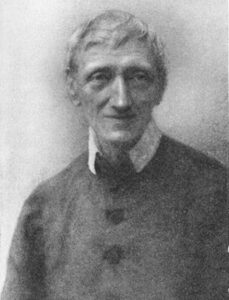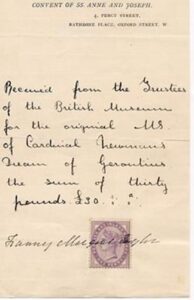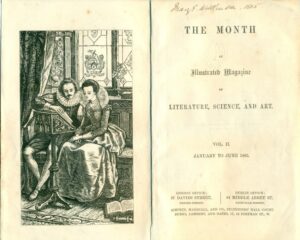Archives Blog December 2020
Venerable Mother Magdalen Taylor, St John Henry Newman, and the ‘Dream of Gerontius’
Given all that has transpired in the intervening period – not least of course the worldwide trauma and loss caused by the coronavirus – it seems almost strange to think that it was just a little over a year ago, on October 13th 2019, that Cardinal John Henry Newman (below, left), widely acknowledged as the greatest English theologian of the nineteenth century, was formally canonised at a beautiful ceremony at St Peter’s Square in Rome.  In this post I am just going to say a little about the association between the great cardinal and Mother Magdalen Taylor, foundress of the Poor Servants of the Mother of God. They were not in regular communication, and their complete surviving correspondence – which has recently been published, with the kind permission of the Fathers of the Birmingham Oratory – consists of just 34 items, covering the period 1862 to 1885. A display of these letters at St Mary’s Convent in Brentford was postponed due to the outbreak, but it is hoped to resume it when conditions improve.
In this post I am just going to say a little about the association between the great cardinal and Mother Magdalen Taylor, foundress of the Poor Servants of the Mother of God. They were not in regular communication, and their complete surviving correspondence – which has recently been published, with the kind permission of the Fathers of the Birmingham Oratory – consists of just 34 items, covering the period 1862 to 1885. A display of these letters at St Mary’s Convent in Brentford was postponed due to the outbreak, but it is hoped to resume it when conditions improve.
 Nonetheless, one very significant outcome of the fruitful collaboration to which this correspondence bears witness was the first publication, in a journal of which Mother Magdalen was then the editor, of Newman’s greatly acclaimed poem, ‘The Dream of Gerontius’. The poem describes, in eloquent and evocative language, the journey of a soul from death to purgatory, ending with the promise of ultimate salvation. The poem has garnered even greater accolades due to its partial setting to music by Sir Edward Elgar in 1900, one of that great composer’s first acknowledged masterpieces. The original performing score is shown, right, signed by the performers when it was originally given in Birmingham Town Hall in October 1900, little over five months after Mother Magdalen’s death. Mother Magdalen would have been greatly pleased to see that the manuscript is headed ‘A.M.D.G.’, the Latin abbreviation which translates as ‘To the Greater Glory of God’. This motto, particularly associated with the Jesuits, appeared at the head of most of Mother Magdalen’s own letters, following the period in which she became a Religious Sister. It is a fitting testament to the guiding principle of both her life’s work, and that of St John Henry Newman.
Nonetheless, one very significant outcome of the fruitful collaboration to which this correspondence bears witness was the first publication, in a journal of which Mother Magdalen was then the editor, of Newman’s greatly acclaimed poem, ‘The Dream of Gerontius’. The poem describes, in eloquent and evocative language, the journey of a soul from death to purgatory, ending with the promise of ultimate salvation. The poem has garnered even greater accolades due to its partial setting to music by Sir Edward Elgar in 1900, one of that great composer’s first acknowledged masterpieces. The original performing score is shown, right, signed by the performers when it was originally given in Birmingham Town Hall in October 1900, little over five months after Mother Magdalen’s death. Mother Magdalen would have been greatly pleased to see that the manuscript is headed ‘A.M.D.G.’, the Latin abbreviation which translates as ‘To the Greater Glory of God’. This motto, particularly associated with the Jesuits, appeared at the head of most of Mother Magdalen’s own letters, following the period in which she became a Religious Sister. It is a fitting testament to the guiding principle of both her life’s work, and that of St John Henry Newman.
There are, in fact, a number of parallels between the careers of Mother Magdalen and Newman. Both were converts from the Church of England, a very painful process at that time when denominational boundaries were much more hard-edged than they are today. They were also both in some sense religious founders, Newman of an English branch of the Roman Oratory founded by St Philip Neri, Mother Magdalen of an entirely new religious congregation of Sisters, inspired by the work of those religious orders which had been established to relieve the spiritual and material needs of the poor and vulnerable. But Mother Magdalen’s admiration for Newman greatly predated her founding of the SMG congregation in 1872, and is reflected in a letter which she wrote to him in 1868, thanking him for the gift of his Verses on Various Occasions, and referring to the guidance which his poems provided for her in her search for religious truth. Another much valued document is the receipt (below, right), authenticated by Mother Magdalen’s own signature, for the sale of her version of the manuscript of Newman’s poem to the British Library in 1891. Despite her admiration for Newman, she was in constant need of finance fort the SMG works in support of the poor, to which these funds would no doubt have contributed.
 At the time of her publication of the poem, in the 1860s, Fanny Taylor (as she then was), was a very determined and hard-working recent Catholic convert in her early thirties. In 1864, despite being already very active in social, pastoral and literary work in support of the Church, she founded a literary journal The Month. From the first, the magazine received the support of the English Jesuits based at Farm Street in Mayfair, London, who were eventually to take over the magazine after Mother Magdalen had been responsible for editing it for just one year. She later wrote: ‘Did I really carry it on for a year? I know the time seemed very long and very hard.’
At the time of her publication of the poem, in the 1860s, Fanny Taylor (as she then was), was a very determined and hard-working recent Catholic convert in her early thirties. In 1864, despite being already very active in social, pastoral and literary work in support of the Church, she founded a literary journal The Month. From the first, the magazine received the support of the English Jesuits based at Farm Street in Mayfair, London, who were eventually to take over the magazine after Mother Magdalen had been responsible for editing it for just one year. She later wrote: ‘Did I really carry it on for a year? I know the time seemed very long and very hard.’
The correspondence with Newman over The Month bears witness to Mother Magdalen’s determination to ensure that it would become a first-rate literary journal, providing thoughtful and stimulating content for an educated Catholic audience often alienated by the anti-Catholic stance of much contemporary English journalism and periodical literature. The eventual reward for her acumen was to be Newman’s great poem, serialised in the last two editions of the journal which she edited, in May and June of 1865 (the cover page is reproduced, below, left). Mother Magdalen had been successful in obtaining a number of short pieces from Newman.  But her abiding concern was to obtain from him an article or longer contribution, knowing what it would mean for the future of the journal to obtain a major work from such a distinguished and highly-regarded writer. Early in April 1865 she wrote him an earnest appeal, saying of the journal ‘it is steadily gaining ground [and] I want to improve it.’ His letter of reply must have followed immediately; her request was successful beyond anything she could have imagined, and to her was given the great honour of first publishing what was shortly to be hailed as a masterpiece.
But her abiding concern was to obtain from him an article or longer contribution, knowing what it would mean for the future of the journal to obtain a major work from such a distinguished and highly-regarded writer. Early in April 1865 she wrote him an earnest appeal, saying of the journal ‘it is steadily gaining ground [and] I want to improve it.’ His letter of reply must have followed immediately; her request was successful beyond anything she could have imagined, and to her was given the great honour of first publishing what was shortly to be hailed as a masterpiece.
Of the immediate circumstances of the first publication of the ‘Dream of Gerontius’, the story has long been current that Newman rescued the manuscript for Mother Magdalen from his wastepaper basket. Commentators then and since have cast doubt upon this detail, which does not seem characteristic of Newman’s attitude to his literary output. But what is certain is that Newman had no immediate intention of publishing the poem, which then existed only on multiple scraps of paper, and that it was Mother Magdalen’s importuning which led directly to its publication. This version of the manuscript, carefully conserved, can now be seen in the beautiful museum recently established by the Oratorian Fathers in Birmingham, where Newman had his home for the last forty or so years of his life. As for The Month itself, it was to continue in publication under its new management until 2001! The photograph above (courtesy of Patricia MacAulay) shows some of the small group of the SMGs and their friends who were honoured to be in St Peter’s Square for this great event. Mother Magdalen herself was declared ‘Venerable’ in 2014, and all of her Sisters, their friends and supporters, are united in their prayers that one day she will follow Newman in being elevated to the altars of the Church.
This version of the manuscript, carefully conserved, can now be seen in the beautiful museum recently established by the Oratorian Fathers in Birmingham, where Newman had his home for the last forty or so years of his life. As for The Month itself, it was to continue in publication under its new management until 2001! The photograph above (courtesy of Patricia MacAulay) shows some of the small group of the SMGs and their friends who were honoured to be in St Peter’s Square for this great event. Mother Magdalen herself was declared ‘Venerable’ in 2014, and all of her Sisters, their friends and supporters, are united in their prayers that one day she will follow Newman in being elevated to the altars of the Church.
Paul Shaw
